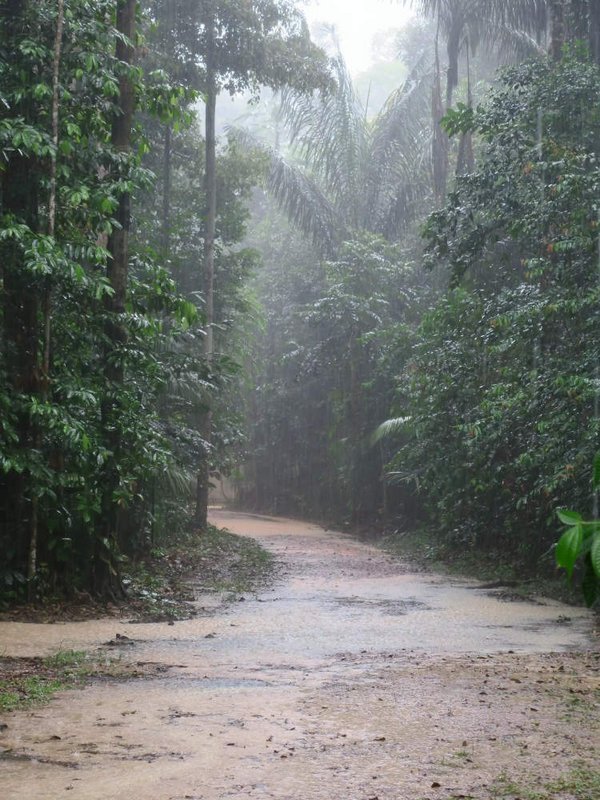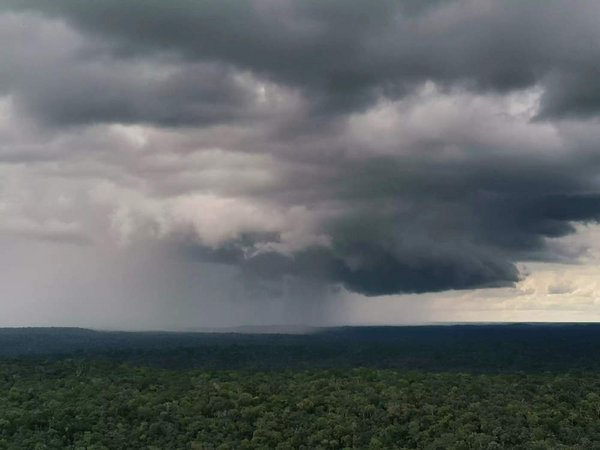Nanoparticle Bursts over the Amazon Rainforest
Mainz/Leipzig, 08.11.2024 – MPIC
Rainfall induces bursts of natural nanoparticles that can form clouds and further precipitation over the Amazon rainforest
Mainz/Leipzig. Atmospheric aerosol particles are essential for the formation of clouds and precipitation, thereby influencing the Earth’s energy budget, water cycle, and climate. However, the origin of aerosol particles in pristine air over the Amazon rainforest during the wet season is poorly understood. A new study, led by the Max Planck Institute for Chemistry in Mainz, reveals that rainfall regularly induces bursts of newly formed nanoparticles in the air above the forest canopy. Gabriela Unfer (TROPOS) and Mira Pöhlker (TROPOS and Leipzig University) from Leipzig were also involved.
During the wet season in the Amazon rainforest heavy rainfall frequently occurs during the afternoon. For clouds and precipitation to develop, tiny airborne particles known as cloud condensation nuclei are required for water vapor to condense and form cloud droplets. But what are the origins of these cloud condensation nuclei?
An international research team from Germany, Brazil, Sweden, and China now showed that rainfall regularly induces bursts of nanoparticles that can grow to form cloud condensation nuclei. The scientists analyzed comprehensive long-term measurements of aerosol particles, trace gases, and meteorological data from the Amazon Tall Tower Observatory, ATTO, which is equipped with sophisticated instrumentation and measurement towers that are up to 325 m high. The observatory is located in the middle of the Amazon rainforest in northern Brazil, about 150 kilometers north-east of Manaus, and jointly operated by scientists from Germany and Brazil.
Luiz Machado, first author of the study now published in the journal Nature Geoscience, explains: “Rainfall removes aerosol particles and introduces ozone from the atmosphere into the forest canopy. Ozone can oxidize plant-emitted volatile organic compounds, especially terpenes, and the oxidation products can enhance the formation of new particles, leading to temporary bursts of nanoparticles.”
Nanoparticle concentrations are highest just above the forest canopy
The researchers discovered that nanoparticle concentrations are highest just above the forest canopy and decrease with increasing altitude. “This gradient persists throughout the wet season, indicating continuous particle formation in the canopy and an upward flux of newly formed particles that can grow by further uptake of low volatile molecules and serve as cloud condensation nuclei”, adds Christopher Pöhlker, co-author and research group leader at the Max Planck Institute for Chemistry. Among the low volatile molecules involved in the formation and growth of natural nanoparticles in the atmosphere are oxygen- and nitrogen-containing organic compounds that are formed upon oxidation of isoprene, terpenes, and other volatile organic compounds, which are naturally emitted by plants and oxidized by ozone and hydroxyl radicals in the air.
Earlier studies had detected new particle formation in the outflow of convective clouds in the upper troposphere and suggested a downward flux rather than an upward flux of newly formed nanoparticles.
“Our findings imply a paradigm shift in the scientific understanding of interactions between the rainforest, aerosols, clouds, and precipitation in the Amazon, which are important for regional and global climate”, concludes Ulrich Pöschl, co-author and director at the Max Planck Institute for Chemistry.
About ATTO:
The Amazon Tall Tower Observatory (ATTO) is an internationally collaborative research site in the central Amazon, dedicated to studying atmospheric processes and the exchange of energy, water, and gases between the biosphere and atmosphere. It is one of the world’s most critical observatories for understanding the impacts of climate change on tropical forests.
Kontakt:
Prof. Dr. Luiz Augusto Machado, Max Planck Institute for Chemistry, Mainz, Germany
E-Mail: l.machado[at]mpic.de
Prof. Dr. Mira Pöhlker, TROPOS und Universität Leipzig, Germany
https://www.tropos.de/institut/ueber-uns/mitarbeitende/mira-poehlker
Original publication:
Luiz A. T. Machado, Gabriela R. Unfer, Sebastian Brill, Stefanie Hildmann, Christopher Pöhlker, Yafang Cheng, Jonathan Williams, Harder Hartwig, Meinrat O. Andreae, Paulo Artaxo, Joachim Curtius, Marco A. Franco, Micael A. Cecchini, Achim Edtbauer, Thorsten Hoffmann, Bruna Holanda, Theodore Khadir, Radovan Krejci, Leslie A. Kremper, Yunfan Liu, Bruno B. Meller, Mira L. Pöhlker, Carlos A. Quesada, Akima Ringsdorf, Ilona Riipinen, Susan Trumbore, Stefan Wolff, Jos Lelieveld, and Ulrich Pöschl
Frequent nanoparticle bursts in the Amazon rainforest
Nature Geoscience, November, 8, 2024, doi: 10.1038/s41561-024-01585-0
https://doi.org/10.1038/s41561-024-01585-0


